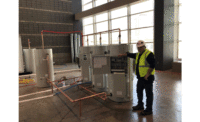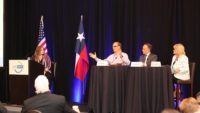Like many other industry groups and organizations, the Plumbing Industry Leadership Coalition (PILC) held its annual meeting via video conference earlier this year. PILC normally hosts even-numbered year meetings in conjunction with the Emerging Water Technologies Symposium, which was postponed to 2021 due to the ongoing COVID-19 pandemic.
The PILC was created to provide a forum for the exchange of information through the leadership of plumbing industry associations representing manufacturers, plumbing systems, certification bodies and stakeholders having an influence on policy. The goal is to seek common ground on plumbing industry issues, and then to address and promote the issues as a unified coalition.
This year’s meeting covered the COVID-19 pandemic and industry response, plumbing industry research initiatives as well as government affairs updates.
Rehabilitating water systems
After the 2020 PILC meeting agenda items were finalized, Purdue University’s Dr. Andrew Whelton, PhD., spoke about the rehabilitation of building water systems. Whelton’s presentation focused on the need to address water quality in building water systems after emergencies, such as the coronavirus pandemic.
Whelton noted how COVID-19 has prompted low to no water use in more than 5.6 million buildings in the U.S. alone, which leads to numerous health risks.
During short-term stagnation, high concentrations of metals and harmful organisms have been found in building water systems, he pointed out. Those include copper, lead and Legionella, amongst other pathogens.
When the pandemic first struck, there were zero guidance documents about building plumbing stagnation and recommissioning, Whelton noted. Today, there are more than 30 guidance documents pertaining to flushing and disinfecting water systems upon reopening buildings that were partially or totally shut down due to the COVID-19 pandemic. These documents were created by national, state and city governments, public and private utilities, private contractors, trade industry associations, nonprofit organizations and manufacturers.
“The pandemic is a defining moment in history,” Whelton says. “The plumbing sector can collectively advance public awareness and public health.”
NIST identifies plumbing industry research needs
During the meeting, Andrew Persily, Energy and Environment Division chief at the National Institute of Standards and Technology (NIST), presented findings of NIST’s report, “Measurement Science Research Needs for Premise Plumbing Systems.”
The report acknowledges the fact that plumbing systems are currently being designed, installed and operated in vastly different ways from what is supported by technical data and understanding embodied in current codes, standards and practices. Plumbing design approaches, codes and standards have not kept pace with these changes, the report notes, in large part because of the existence of significant technical knowledge gaps.
Research is needed to address these gaps in support of water efficiency and water quality goals to ensure the effectiveness of these systems today and in the future.
Persily made reference to the 59 research recommendations cited within the report.
“Our goal is to identify research needs both critical to the design of new systems, and the operation and retrofit of existing systems — all about energy efficiency and water quality,” he says. “I want to make it clear that NIST will not be conducting all these research programs. We've yet to determine what we can do, given our existing staff, facilities and resources. This is hopefully a task for the entire stakeholder community.”
Persily noted that NIST will engage industry stakeholders in discussions on project prioritization and how to best move the research forward. NIST will be scheduling virtual workshops in the near future to start the process.
“This [report] is a clear example of the value that can be derived from public-private partnerships,” IAPMO CEO Russ Chaney says. “The codes and standards environment has been a proving ground for that type of public-private interaction. This information is extremely important to us because it’s hopefully going to bring badly needed resources and subject matter experts to the table to allow us to get parts of our codes updated from the good work done by Roy Hunter back in the 1930s and 1940s. Well done to NIST. The plumbing industry and our individual organizations look forward to participating.”
To view the entire report, visit https://bit.ly/36POsY2.
Legislation and regulatory affairs
In a joint presentation, Stephanie Salmon, federal government affairs consultant for PMI; Sara Yerkes, senior vice president, government relations, ICC; and Dain Hansen, executive vice president, government affairs, IAPMO, discussed various federal and state legislative and regulatory issues.
After discussing various coronavirus bills, aid packages and tax changes, the conversation moved to the two major water-related bills in the Senate.
America’s Water Infrastructure Act of 2020 (AWIA) would authorize 20 water resource projects totaling about $17 billion, and 14 new or modified feasibility studies. The Drinking Water Infrastructure Act (DWIA) is a smaller companion bill that would provide approximately $2.5 billion in federal authorizations for drinking water infrastructure.
Other important legislation on the horizon is the Lead and Copper Rule — the first major overhaul since 1991. Water utilities have been critical of the EPA for unnecessarily complicating the rule. The agency currently requires water utilities to replace lead pipes when lead concentrations exceed 15 parts per billion (ppb) in at least 10% of sampled tap water. The proposed revision would have utilities develop plans to replace lead pipes when the lead levels exceed 10 ppb, and start to replace some pipes when concentrations exceed 15 ppb.
The EPA is looking at summer’s end to finalize revisions, which will ramp up regulatory pressure to get utilities to replace lead pipes, but to do so over time rather than requiring full replacement all at once, presenters noted.
Discussion then followed on the EPA’s Federal Register call for comments on the EPA’s WaterSense program. It was noted that this activity is widely assumed to be a result of criticism of water efficient plumbing products by President Donald Trump.
In response, Mary Ann Dickinson, president and CEO of AWE, asked the PILC as well as individual members to sign a letter of comment in response to the review stating their strong support for the program. Additionally, Pete DeMarco will draft and circulate a PILC letter of support for the WaterSense program for submission to Federal Register. Individual PILC organizations were also encouraged to submit their own letters of support.
In closing, the PILC chairs thanked attendees, saying they hope to meet in-person in San Antonio, Texas, next year.





